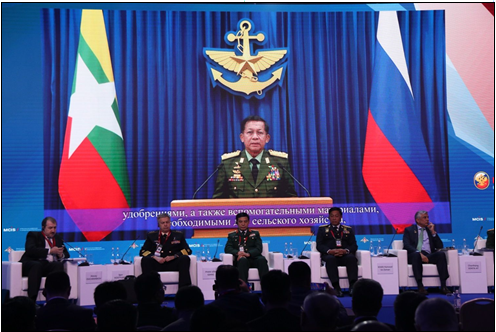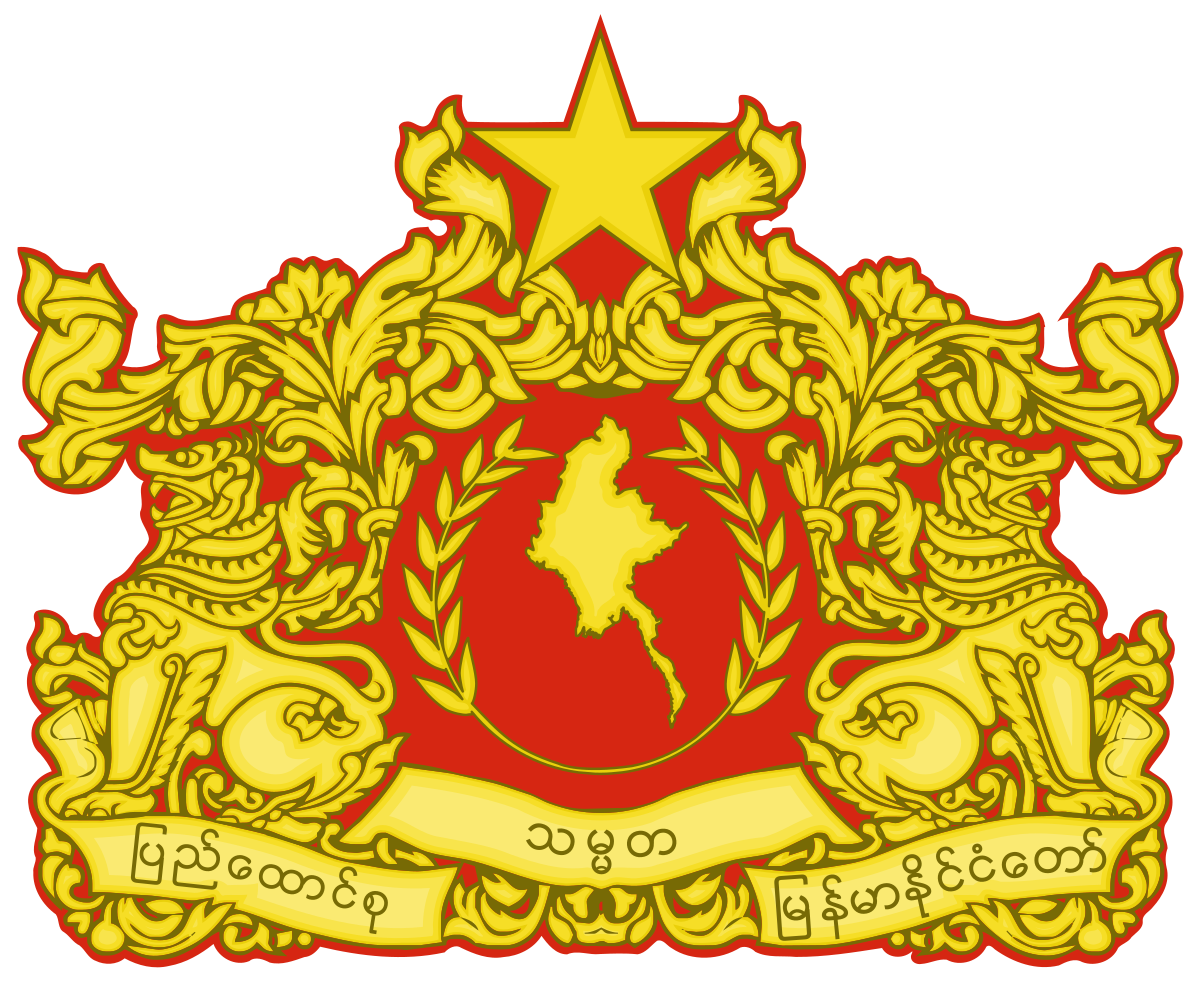Chairman of State Administration Council Commander-in-Chief of Defence Services Senior General Min Aung Hlaing Sends Video Message to XI Moscow Conference on International Security in 2023
Chairman of State Administration Council Commander-in-Chief of Defence Services Senior General Min Aung Hlaing Sends Video Message to XI Moscow Conference on International Security in 2023
Ministry of Defense/ Naypyitaw / August 22, 2023

The Chairman of the State Administration Council (SAC) Commander-in-Chief of Defence Services Senior General Min Aung Hlaing sent a video message to the XI Moscow Conference on International Security in 2023 (MCIS-2023) which was held at the Patriotic Park of the Russian Federation in Moscow of Russia on 15 August.
The conference was launched at 10 am local standard time with a video message from Russian President Vladimir Putin. Then, the Plenary Session 1 was held under the topic “Security in the Middle East and the African Continent: military aspects” from 12:20 pm to 2 pm; the Plenary Session 2 under “Security in the Asia-Pacific Region” from 3:20 pm to 4:50 pm; the Plenary Session 3 under “Interaction of Defence Agencies: Conditions and Expectations” from 5:20 pm to 7 pm. Next, the address delivered by the SAC Chairman Commander-in-Chief of Defence Services in the form of a video message was screened from 3:52 pm to 4:08 pm during the Plenary Session 2.
The full messages delivered by the SAC Chairman Commander-in-Chief of Defence Services are as follows:
· Although it’s my desire to attend the conference in person, I can only send a video message as I am fully occupied with daily work.
· “The Important Role of the Unity of ASEAN in Peace and Stability of the Asia-Pacific Region” is the main message of my discussion.
· Asia-Pacific Region covers Asian land territories, Pacific and Indian Oceans, which is also a home to over 4.3 billion people or more than half the global population. The world’s most populous countries, China and India, also lie in the region.
· Food security is the most basic factor of the region where over 60 percent of the global population is living.
· Some countries utilize the dollar currency as a weapon to threaten finance and security in trading the main agro-inputs including fuel and chemical fertilizers.
· The trade value in the Asia-Pacific region reached US$19 trillion in the region in 2022 comprising $3.5 trillion worth of economic service.
· The Asia-Pacific region has the heaviest maritime traffic in the world, where about 59 per cent of the goods are unloaded and 40 per cent loaded. A total of 20 of 30 world’s high-class container ports are located in the Asia-Pacific region, possessing 56 per cent of the world’s maritime container transport route.
· China, India and Indonesia are the leading oil producers of the region. Although China is a top oil producer, it has to import oil due to high local demand.
· India is the third largest oil consumer in the world after the US and China. The Asia-Pacific region produced 8.3 per cent of the global oil production in 2022 and used 38 per cent of the global oil production to meet the local demand.
· According to the IEA statistics, the region demands 30.8 million barrels of oil per day at present and it will reach 38.5 million barrels per day in 2030 to boom the oil and natural gas market in the region.
· Because of its high population and important locality for global trade, its vitality in multiple sectors including security issues is increasing. In this regard, the US, European Union and NATO are paying more attention to the region for their own interest and promoting direct or indirect engagements with the countries of the region.
· The world is now facing disparities and disagreements due to the breakout of an epidemic, rivalry among global powers, unsolved territorial disputes and recent crises. Intense rivalry for supremacy in the security affairs comes alongside the huge shift in the balance of power.
· weaker situation of stability and security measures across the world remarkably affect the security and economic sectors of the Asia-Pacific region.
· The organizations like ASEAN are playing a pivotal role in mitigating the impacts of global instability and insecurity.
· Promotion of mutual talks, realization of conflict resolution processes, development of economic cooperation, and encouragement of cooperative involvement of the countries will be helpful to overcome challenges and foster peace, stability and prosperity in the global environment.
· In 1967, initial members Indonesia, Malaysia, the Philippines, Singapore and Thailand signed the ASEAN declaration to form the ASEAN.
· In 1984, Brunei joined the ASEAN, Vietnam in 1995, Myanmar and Laos in 1997 and Cambodia in 1999.
· ASEAN member states with different religions have been firmly upholding the basic principles in the ASEAN Charter adopted in its initial stage as non-interference in internal affairs of a member state and peaceful co-existence for 56 years to serve the interests of member states in unison.
· Currently, the ASEAN with more than 687 million population and US$-3.66 trillion of GDP is capable of serving the interests of inside and outside regional countries by using its strong power and capacity.
· Moreover, ASEAN countries utilizing underground and aboveground resources and water resources fulfill energy and food requirements of the world on one hand. The ASEAN in Asia-Pacific region becomes a drive for regional solidarity and cooperation.
· It could forge the formation of ASEAN Economic Community, Political and Security Community, Social and Cultural Community as well as the unity in economic, political, social and cultural sectors among ASEAN countries.
· Although the ASEAN is not a military alliance, its defence power consolidation is very powerful. The consolidation between Vietnam with military experiences and Myanmar and other ASEAN countries possessing powerful weapons is remarkably reliable for the world.
· The ASEAN plays a key role in meetings between ASEAN and its partner countries such as East ASIA Summits and ASEAN+3 summits in relations with other powerful countries in Asia-Pacific region. Moreover, the association influences over the regional cooperation and helps strengthen mutual cooperation to enhance peaceful relation measures.
· As such, the ASEAN unity is essential for fostering the peace, stability and prosperity of Asia-Pacific region.
· Only when the ASEAN is strengthening with consolidation will it be powerful for the Asia-Pacific region. While initiating the unity among member States, the ASEAN is facing challenges of such unity.
· Regarding Myanmar, political, economic and security measures can be stabilized in most of the country except some areas of Myanmar.
· Myanmar is striving for ensuring security, peace and stability, rule of law and economic development of the nation so as to hold a free and fair multiparty democratic general election to hand over the State’s responsibilities to the elected political party under the democratic norms.
· The ASEAN bridges the Indian Ocean and the Pacific Ocean, as a focal point of the Asia-Pacific region. As the unity of ASEAN is of great importance for the peace and stability of the whole Asia-Pacific region, it is necessary to overcome and respond to deep challenges of the region with firm unity and cooperation of regional countries including the ASEAN.
· All are required to join hands in seeking peaceful solutions to conflicts and problems among the regional countries and to grasp the opportunities to develop the region.
Next, the XI MCIS-2023 concluded at 6.30 pm local standard time.
Heads of State from five countries including the SAC Chairman Commander-in-Chief of Defence Services Senior General Min Aung Hlaing sent video messages to the meeting, and it was attended by more than 800 attendees including 20 defence ministers from 20 countries comprising SAC member Deputy Prime Minister and Minister for Defence Admiral Tin Aung San, 16 deputy defence ministers from 16 countries, 12 directors from 12 countries.
Source: Myawady Daily Newspaper (17-8-2023)




